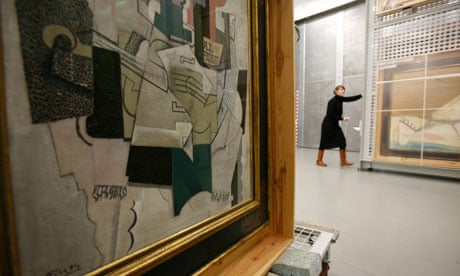Looking at cubism is one of life's rarest pleasures. Rare because it's not something anyone does that often. The cubist paintings of Pablo Picasso and Georges Braque are widely regarded as 20th-century art's equivalent of atonal music: incredibly difficult, offering rewards that are in their nature ascetic and remote from everyday life.
This is a misunderstanding. Fans of modernist music might tell me it's a misunderstanding of Schoenberg, too: in his acclaimed history of avant-garde music The Rest Is Noise, the critic Alex Ross sees European modernism as possessing an apocalyptic antipathy to the ordinary sounds of the street, which were returned to avant-garde music only by the American minimalists. In this account, Schoenberg and his followers were the aural equivalents of abstract painters such as Kandinsky, who engaged in the pursuit of the absolute.
By contrast, the great cubist experiment of Picasso and Braque before the first world war was never a rejection of the material, visible, ordinary world. It was never a pursuit of the absolute. It was an investigation of reality and of perception. It invented abstract means to achieve representational ends. That's why "pleasure" is the right word for looking at a cubist painting – when we can find time to look at one.
The other day I was at Tate Modern and found some time to look at Picasso's 1914 painting Bowl of Fruit, Violin and Bottle. It was good that I was a bit tired at the end of the day and had had a drink, because what makes it hard to cope with cubism is the tension of the museum visitor primed to try and rationally understand what's there. This painting is a world in which to let your imagination ramble: picking on one detail after another, the profile of a musical instrument, globs of grapes hanging in space, the outline of a newspaper, a bulge you realise is a chair leg. Some shapes are outlined, others are touched into conventional three-dimensional life; others are not there at all.
But if you can relax your gaze enough and just enjoy the painting long enough, something really amazing happens (and it happens with all cubist masterpieces): a chemistry in your process of perception produces a solid feeling of the things Picasso was looking at, that he was touching with his brain – the fruit, the bottle, the newspaper, the cafe table. A place and a time swim darkly into view; the world is revealed in its majesty. And this is fun.
Cubism is the road not taken by later modernist art. The later pursuit of the absolute produced the inevitable reaction of postmodernism – and the loss of depth that entailed. So, we inhabit a shallowed and evacuated art world that sees itself as "subverting" the heaviness of modernist art. Art would be so much better in our time if it could forget that false dilemma, and recover the legacy of cubism.

Comments (…)
Sign in or create your Guardian account to join the discussion